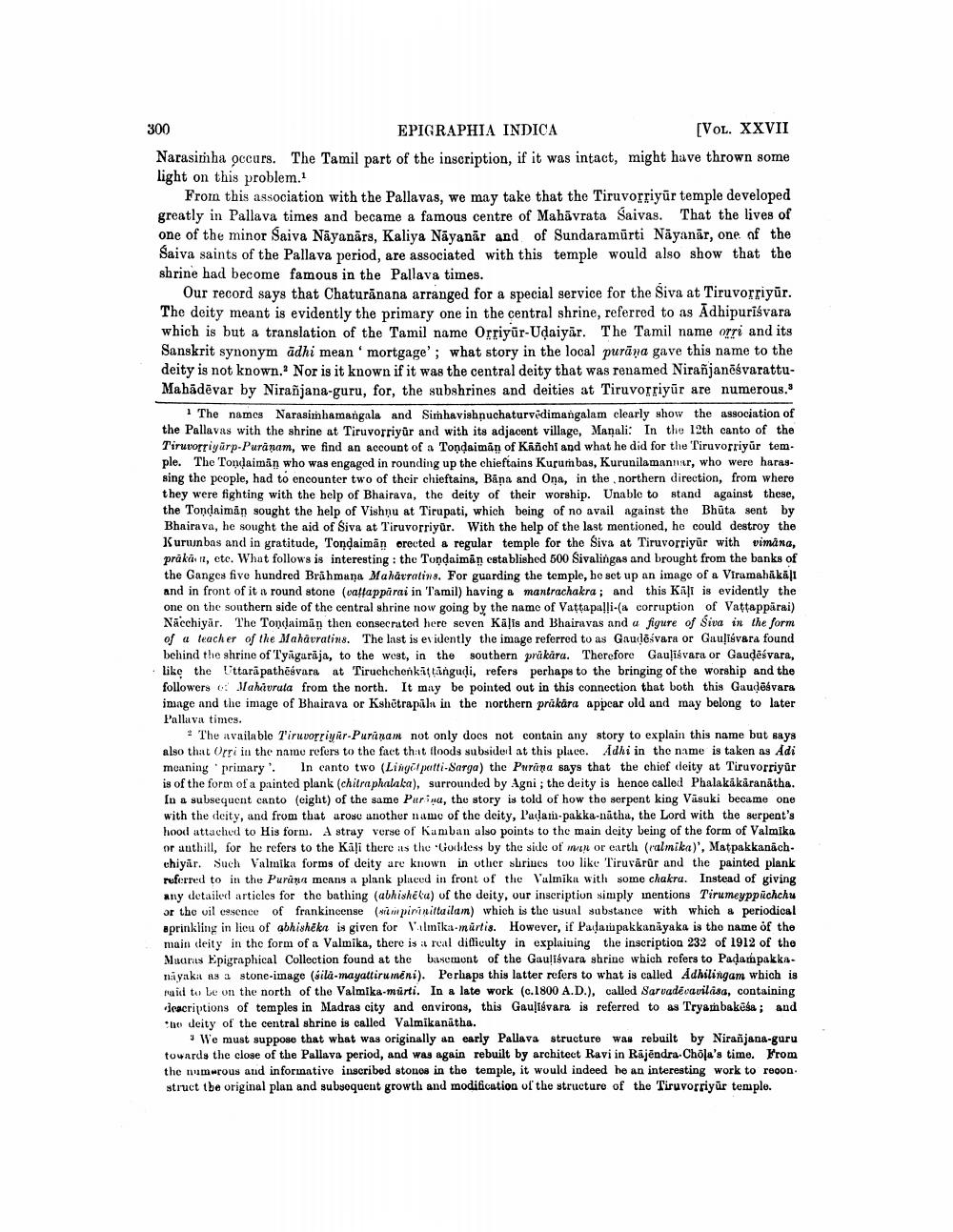________________
300 EPIGRAPHIA INDICA
(VOL. XXVII Narasimha occurs. The Tamil part of the inscription, if it was intact, might have thrown some light on this problem.
From this association with the Pallavas, we may take that the Tiruvorriyūr temple developed greatly in Pallava times and became a famous centre of Mahavrata Saivas. That the lives of one of the minor Saiva Näyanārs, Kaliya Nāyanār and of Sundaramürti Näyanar, one of the Saiva saints of the Pallava period, are associated with this temple would also show that the shrine had become famous in the Pallava times.
Our record says that Chaturānana arranged for a special service for the Siva at Tiruvorriyūr. The deity meant is evidently the primary one in the central shrine, referred to as Adhipuriśvara which is but a translation of the Tamil name Orriyūr-Udaiyār. The Tamil name orri and its Sanskrit synonym adhi mean mortgage'; what story in the local purāņa gave this name to the deity is not known. Nor is it known if it was the central deity that was renamed NiranjanēśvarattuMahādēvar by Nirañjana-guru, for, the subshrines and deities at Tiruvorriyūr are numerous.
1 The names Narasimhamangala and Simhavishnuchaturvedimangalam clearly show the association of the Pallavas with the shrine at Tiruvorriyūr and with its adjacent village, Manali: In the 12th canto of the Tiruvorriyūrp-Purānam, we find an account of a Tondaimãn of Kanchi and what he did for the Tiruvorriyūr tem. ple. The Tondaimān who was engaged in rounding up the chieftains Kurumbas, Kurunilamannar, who were harassing the people, had to encounter two of their chieftains, Bana and Ona, in the northern direction, from where they were fighting with the help of Bhairava, the deity of their worship. Unable to stand against these, the Tondaimán sought the help of Vishnu at Tirupati, which being of no avail against the Bhūta sent by Bhairava, he sought the aid of Siva at Tiruvorriyūr. With the help of the last mentioned, he could destroy the Kurunbas and in gratitude, Tondaimān orected a regular temple for the Siva at Tiruvorriyur with vimana, prākā 12, etc. What follows is interesting : the Tondaiman established 500 Sivalingas and brought from the banks of the Ganges five hundred Brāhmana Maharratine. For guarding the temple, ho set up an image of a Viramahakali and in front of it a round stone (vattapparai in Tamil) having a mantrachakra ; and this Kāļi is evidently the one on the southern side of the central shrine now going by the name of Vattapalli-la corruption of Vattapparai) Nacchiyar. The Tonelaiman then consecrated here seven Kāļis and Bhairavas and a figure of Siva in the form of a teacher of the Maharratins. The last is evidently the image referred to as Gaudēsvara or Gaulīśvara found behind the shrine of Tyagarāja, to the west, in the southern präkära. Therefore Gaulīśvara or Gaudēśvara, like the Uttarā pathēsvara at Tiruchchenkittangudi, refers perhaps to the bringing of the worship and the followers o: Jahavrata from the north. It may be pointed out in this connection that both this Gaudēvara image and the image of Bhairava or Kshetrapal in the northern prākāra appear old and may belong to later Pallava times.
* The available Tiruvorriyir-Purinam not only does not contain any story to explain this name but says also that Orri in the name refers to the fact that floods subsidel at this place. Adhi in the name is taken as Adi moaning primary' In canto two (Linyol patti-Sarga) the Purana says that the chief deity at Tiruvorriyur is of the form of a painted plank (chitraphalaka), surrounded by Agni; the deity is hence called Phalakakaranatha. In a subsequent canto (eight) of the same Purina, the story is told of how the serpent king Väsuki became one with the deity, and from that aroso another name of the deity, Padan-pakka-natha, the Lord with the serpent's hood attached to His form. A stray verse of Kamban also points to the main deity being of the form of Valmika or anthill, for he refers to the Kāļi there is the Goddess by the side of man or earth (ralnika)', Matpakkanách. chiyar. Such Valmika forms of deity are known in other sbriucs too like Tiruvarur and the painted plank referred to in the Purana means a plank placed in front of the Valmika with some chakru. Instead of giving any detailed articles for the bathing (abhishēlu) of the deity, our inscription simply inentions Tirumeyppichchu or the vil essence of frankincense (rem piriniltailam) which is the u
wittailam) which is the usual substance with which & periodical aprinkling in lieu of abhisheken is given for Vilmika-murtis. However, if Padampakkanayaka is tho name of the main deity in the form of a Valmika, there is it real difficulty in explaining the inscription 232 of 1912 of the Maanus Epigraphical Collection found at the basement of the Gaulisvara shrine which refers to Padampakkanayakit as a stone-image (sila-mayattirumeni). Perhaps this latter refers to what is called Adhilingam which is raid to be on the north of the Valmika-murti. In a late work (c.1800 A.D.), called Sarvadevavilasa, containing descriptions of temples in Madras city and environs, this Gaulisvara is referred to as Tryambakesa; and ne deity of the central shrine is called Valmikanátha.
"We must suppose that what was originally an early Pallava structure was rebuilt by Niranjana-guru towards the close of the Pallava period, and was again rebuilt by architect Ravi in Rajendra Chola's time. From the numerous and informative inscribed stones in the temple, it would indeed he an interesting work to recon. struct the original plan and subsequent growth and modification of the structure of the Tiruvorriyūr templo.




